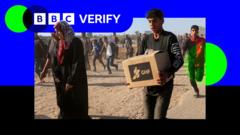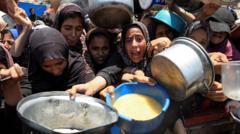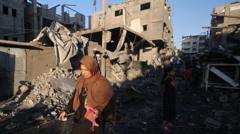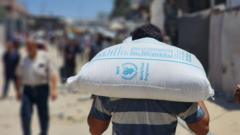Air dropping aid in Gaza has been deemed a desperate measure that does little to alleviate the hunger crisis at hand. Analysts argue that sustainable solutions, such as a ceasefire and unrestricted aid access, are essential for lasting relief.
The Limitations of Airdropped Aid: A Critical View on Gaza's Hunger Crisis
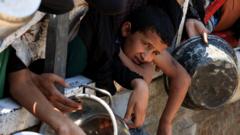
The Limitations of Airdropped Aid: A Critical View on Gaza's Hunger Crisis
An analysis of the ineffectiveness of airborne relief efforts in Gaza amidst ongoing humanitarian challenges.
In recent developments, Israel has proposed air dropping humanitarian aid into Gaza, a response to international pressure from allies highlighting the worsening hunger situation. Notably, leaders from Britain, France, and Germany have issued urgent calls for Israel to lift aid restrictions and facilitate the work of humanitarian organizations to combat the humanitarian crisis unfolding in the region. However, Israel maintains that it imposes no barriers to aid trucks entering Gaza, a claim contradicted by various international organizations and allies.
The observations drawn from past conflicts illustrate the precarious nature of air dropped aid. During conflicts like the Gulf War and the siege of Mostar, such deliveries were often hazardous and ineffective. In Gaza, the situation poses its own unique challenges. Although air drops might provide immediate aid, they do not address the underlying issues that lead to hunger.
Past experiences show that aid delivered from the air can result in dangerous outcomes. For instance, in Iraqi Kurdistan, individuals risked their lives to collect aid amidst minefields, while in Bosnia, dropped pallets sometimes landed in unsafe and inaccessible areas. Given Gaza's dense population and limited space, it raises questions regarding the efficacy of this method.
Current conditions in Gaza are dire, with nearly a third of the population reportedly going days without food, according to the United Nations. Critics argue that without a comprehensive ceasefire and unhindered access to aid through established supply routes like the Ashdod port or the Jordanian border, air drops will only alleviate immediate symptoms without resolving the larger crisis. In a region where desperation runs high, access and distribution of aid remain paramount for any effective humanitarian response.
The observations drawn from past conflicts illustrate the precarious nature of air dropped aid. During conflicts like the Gulf War and the siege of Mostar, such deliveries were often hazardous and ineffective. In Gaza, the situation poses its own unique challenges. Although air drops might provide immediate aid, they do not address the underlying issues that lead to hunger.
Past experiences show that aid delivered from the air can result in dangerous outcomes. For instance, in Iraqi Kurdistan, individuals risked their lives to collect aid amidst minefields, while in Bosnia, dropped pallets sometimes landed in unsafe and inaccessible areas. Given Gaza's dense population and limited space, it raises questions regarding the efficacy of this method.
Current conditions in Gaza are dire, with nearly a third of the population reportedly going days without food, according to the United Nations. Critics argue that without a comprehensive ceasefire and unhindered access to aid through established supply routes like the Ashdod port or the Jordanian border, air drops will only alleviate immediate symptoms without resolving the larger crisis. In a region where desperation runs high, access and distribution of aid remain paramount for any effective humanitarian response.




